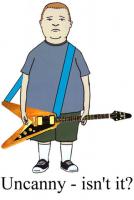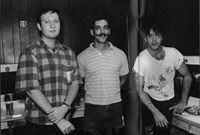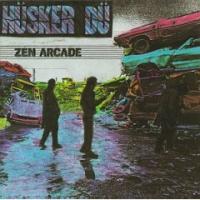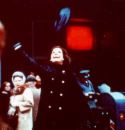It’s time to play a punk rock variation on the ancient What’s My Line quiz show, where you guess the musician and his new career direction. Here are the clues:
 • Suppose your guitar playing and threadbare singing carry such coruscating intensity that concertgoers can hear their ears ringing days later—and this is after your solo acoustic shows.
• Suppose your guitar playing and threadbare singing carry such coruscating intensity that concertgoers can hear their ears ringing days later—and this is after your solo acoustic shows.
• Suppose you were the grittier part of a songwriting team often described as punk’s Lennon and McCartney.
• Suppose Nirvana, the Pixies, My Bloody Valentine, Green Day, the Hold Steady, and much other “alternative rock†couldn’t have existed without you, and yet none of your offspring matched the melding of noise and melody, and the sheer adrenaline rush, that spills out of your best work.
• Suppose a British website theorizes that you and Bobby Hill of King of the Hill are, in fact, the same person.
The mystery guest is Bob Mould, former leader of the umlaut-worthy Twin Cities power trio Hüsker Dü, and later the potent and more refined Sugar. And his new career direction? As I discovered on a recent trip to Washington, D.C., Mould–who has been a dedicated blogger, electronica DJ and man-about-town in the district for several years–is the new advice columnist for an alternative weekly, the Washington City Paper. In his Ask Bob column, Mould invites readers to ask him questions about “music, cooking, travel, politics, religion, neighborhoods, and sociology.â€
You could snicker, but I think that’s a good idea. Mould has always come off as a cerebral everyman. In an era of self-absorbed pundits with inflated egos, who better to dispense advice than the singer who used to scream “everybody’s an authority/ in a free land� And who could offer better travel tips than the driving force behind Hüsker Dü’s “Chartered Trips†from 1984’s epic Zen Arcade, one of the most gorgeous and unsettling songs ever written about the urge to get away?
While I bet Mould has some interesting opinions about paella, Buddhism and the Supreme Court, I’d really like to get him talking about architecture. In late 1982, when Hüsker Dü started making their great leap forward, punk rock was still mostly about tearing down old spaces rather than building new ones, and it was starting to get stale. The exhilarating joyride that was first-generation punk started fragmenting into a dozen hyphenated subgenres (like cowpunk, jazz-punk, and funk-punk) that offered memorable moments without a coherent sense of direction. Meanwhile, the hardcore scene that spawned the Hüskers had started getting just as doctrinaire and predictable as the Seventies dinosaur rock punk had once replaced.
When it comes to building, flaunting hatred or chaos as your “own creation†reduces pretty quickly into tedious nihilist chic. In his excellent book Global City Blues, architect Daniel Solomon compares the hyper-modernist architecture of Rem Koolhaas, and Koolhaas’ celebration of slum chaos in places like Lagos, Nigeria, to that of a “blood-soaked punk band†engaging in “audacious, half-ironic manipulations of media culture.†The problem is, the shock of the new soon loses its ability to shock, and these ironic manipulations have no resonance with the way that people—even punks—actually live. Solomon contrasts Koolhaas’ work with that of Chinese architecture professor Wu Liangyong, who searched for a fresh context for ancient Chinese walls and structures within modern Beijing. While recognizing that radical change was essential, Dr. Wu refused to accept “the idea that change necessarily carried with it the eradication of history.â€
 Hüsker Dü would have been hopeless as purveyors of nihilist chic, since they looked like the most unhip bunch of misfits ever to label themselves a punk band. Mould goes to gyms and seems much healthier these days, but at the time he resembled a paunchy accountant who had spent too many all-nighters studying tax returns. Longhaired, barefoot drummer Grant Hart, the wilder and poppier songwriter, lumbered around like he had shown up for the Sixties two decades late. Lean bassist Greg Norton, with his handlebar mustache, appeared to be just one construction worker’s helmet away from being a member of the Village People. Their lack of punk appearance was, in its own way, completely punk. So was their cryptic name, taken from a children’s memory game (Hüsker Dü is Danish for “do you remember?â€)
Hüsker Dü would have been hopeless as purveyors of nihilist chic, since they looked like the most unhip bunch of misfits ever to label themselves a punk band. Mould goes to gyms and seems much healthier these days, but at the time he resembled a paunchy accountant who had spent too many all-nighters studying tax returns. Longhaired, barefoot drummer Grant Hart, the wilder and poppier songwriter, lumbered around like he had shown up for the Sixties two decades late. Lean bassist Greg Norton, with his handlebar mustache, appeared to be just one construction worker’s helmet away from being a member of the Village People. Their lack of punk appearance was, in its own way, completely punk. So was their cryptic name, taken from a children’s memory game (Hüsker Dü is Danish for “do you remember?â€)
Musically, the band took on a rebuilding project not unlike Dr. Wu’s, in which a sense of history and place were no longer the enemies of radical change. Bob Mould didn’t come off as crazy or high; he was just an ordinary guy, radically reshaping classic rock from Beatles and Who through the Ramones without turning himself into just a shadow of the bands that he once knew. His approach came off as more blunt and personal than that of perhaps his closest musical peers, Boston’s Mission of Burma, who sounded (and still sound, in their fascinating new reincarnation) more like art students using punk as their canvas. And if the Hüskers’ music was less funky and overtly political than that of their swinging California comrades and SST labelmates the Minutemen, it was even more intense and relentless.
At their peak, Hüsker Dü created a new sort of landscape architecture within a rock song. In the remarkably prolific stretch between 1983’s relentless Metal Circus EP and 1985’s pop-punk masterpiece Flip Your Wig, the band took direct aim at the false “anarchy†and romanticized chaos that punk had often become (Metal Circus’ opening salvo, Mould’s “Real World,†skewers the hardcore ethos even as it borrows and surpasses its warp-speed velocity). But beyond those lyrical concerns, they flat-out obliterated hardcore’s rigid strictures on the use of space within songs. The best example is Hüsker Dü ‘s version of the Byrds’ “Eight Miles High,†which 23 years after its release remains my favorite cover song ever.
“Eight Miles High†seems like a particularly un-punk song to cover, given its association with the psychedelic Sixties and musical complexity. The song’s signature four-note cluster and ringing guitar sound came right from the modal explorations of John Coltrane’s “India,†which the Byrds’ Roger McGuinn ingeniously transcribed for his twelve-string Rickenbacker (legend had it that the only tape in the van on a Byrds tour had Coltrane’s 1961 Village Vanguard sessions on one side, and Ravi Shankar on the other).
A typical punk cover would simply have steamrolled over the original, celebrating its noise potential while mocking its naivete—think here of the Circle Jerks doing “Wild in the Streets,†the Dickies’ version of “Nights in White Satin,†or the boatloads of middling So Cal frat-punk that have emerged since then. One of the Eighties’ jangly Paisley Underground bands, like Rain Parade or the Three O’Clock, would have treated the original like a museum piece. But Bob Mould had different ideas. While no jazzbo, he seemed to have an instinctive grasp for the Coltrane-inspired nuances of the original. Yet he took its flight metaphor in a deeper, darker direction that completely nailed, and transcended, the original’s ominous mood of danger and desperate yearning.
 After “Eight Miles High†came Zen Arcade, an overreaching double-album mini-opera chronicling a teenager’s journey in and out of an urban wasteland. Completed in a single 85-hour marathon out of financial necessity, it’s not exactly an audiophile recording; Spot’s production sounds like it came out of the men’s bathroom at a sports arena, and Mould sounds like he has been gargling Drano. When Hüskers fan John Zorn played the record for Ornette Coleman, Ornette instinctively understood the band’s creative use of compressed space, but he thought the lead singer couldn’t possibly be a native English speaker.
After “Eight Miles High†came Zen Arcade, an overreaching double-album mini-opera chronicling a teenager’s journey in and out of an urban wasteland. Completed in a single 85-hour marathon out of financial necessity, it’s not exactly an audiophile recording; Spot’s production sounds like it came out of the men’s bathroom at a sports arena, and Mould sounds like he has been gargling Drano. When Hüskers fan John Zorn played the record for Ornette Coleman, Ornette instinctively understood the band’s creative use of compressed space, but he thought the lead singer couldn’t possibly be a native English speaker.
You can forgive the record its small transgressions, though, because Zen Arcade did so much so astonishingly well. The record (and it still sounds best on vinyl) rips through gonzo teenage depression tunes, sped-up acoustic folk, definitive songs about escape and indecision, and an off-the-wall reworking of the Bo Diddley rhythm called “Hare Krsnaâ€â€”and that’s just side one of four. Side Two segues from ear-blasting hardcore to a nautical dirge. Side three has the most memorable riffs and melodies, and side four offers an old-fashioned rock anthem and 14 minutes of screeching psychedelic feedback. I make no pretensions of objectivity about Zen Arcade, because it’s the record that virtually built my adulthood.
Mould’s hardscrabble realism was too dour for many tastes, including mine sometimes, but it helped him stand out during the brief period in the Eighties when Minneapolis seemed like the center of the musical universe. If the Replacements’ Paul Westerberg was the perpetually underachieving class clown who secretly wrote great stories, and Prince was the exotic transfer student, Bob was the bookish, introspective guy in the back of the room who didn’t buy that it was morning in America and was determined to fight his way through shades of grey. As one of those bookish, introspective guys, I instinctively identified with Mould’s work ethic, and still do. This wasn’t rock for self-styled bad boys who could count on their moms, wives and groupies to clean up their messes; it was fierce, dense, uncompromising music for the rest of us who had to live in the real world, get to work, and get there fast.
 In downtown Minneapolis, a statue now commemorates the spot where the city’s most celebrated working person, the fictional Mary Richards of the Mary Tyler Moore show, famously threw her hat in the air. The statue made me remember that Hüsker Dü once covered the show’s theme song, “Love is All Around,†which was written by the same Sonny Curtis who wrote “I Fought the Law.†Bob Mould never turned the world on with his smile, but if I had my way, his likeness would be right there next to the Mary statue, with his Ibanez Flying V pointed to the skies and his feet planted firmly on the ground. Bob, I suspect, would hate having a statue. All he really wants to do is answer a few of your questions.
In downtown Minneapolis, a statue now commemorates the spot where the city’s most celebrated working person, the fictional Mary Richards of the Mary Tyler Moore show, famously threw her hat in the air. The statue made me remember that Hüsker Dü once covered the show’s theme song, “Love is All Around,†which was written by the same Sonny Curtis who wrote “I Fought the Law.†Bob Mould never turned the world on with his smile, but if I had my way, his likeness would be right there next to the Mary statue, with his Ibanez Flying V pointed to the skies and his feet planted firmly on the ground. Bob, I suspect, would hate having a statue. All he really wants to do is answer a few of your questions.